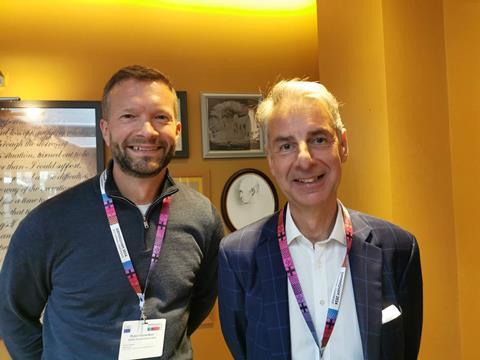Around 800 delegates gathered in Birmingham last week to discuss and debate the challenges facing the office construction sector ŌĆō and a quarter of those present were under 35. Olivia Barber runs through some of the key points from the three-day conference

A decade after its last conference in Birmingham, the British Council for Offices (BCO) returned to the city on Wednesday last week. The three-day event, attended by around 800 participants, began with the announcement of a snap general election and the arrival of 52 intrepid cyclists who had completed a tough 270-mile journey from Newcastle to Birmingham.
Before the conference officially kicked off, the BCOŌĆÖs NextGen group hosted a brunch at the Mailbox, one of BirminghamŌĆÖs grade A office spaces, where several dozen under-35s gathered to network and discuss their work in the sector. Topics of conversation included the flexibility of office spaces due to hybrid working and the importance of office developments incorporating amenities such as museums and cafes.
In his opening speech, Peter Crowther, vice president and soon-to-be president of the BCO, welcomed the fact that there were 200 NextGen delegates in attendance, double the number from last year. The future is looking bright!
Vibrant cities
The theme of this yearŌĆÖs conference was creating vibrancy. Crowther said that in the 10 years since the BCO was last in Birmingham, there had been some ŌĆ£remarkable changesŌĆØ.
ŌĆ£The city famously known as the workshop of the world, now has sizeable commercial office developments,ŌĆØ he said, reeling off 103 Colmore Row, the tallest office tower in Birmingham, Three Snowhill and Paradise Birmingham, where Arup has its third largest office worldwide.
Crowther emphasised how offices ŌĆ£play a big part in making cities vibrant places that people want to come toŌĆØ, which creates ŌĆ£a symbiotic relationshipŌĆØ between the workplace and the cityscape.
Speaking to Crowther ahead of the conference, he had noted that people were attending ŌĆ£to learn and be challenged, itŌĆÖs an agitation to do what we do betterŌĆØ.
While last yearŌĆÖs event had focused on the ŌĆ£new normalŌĆØ of hybrid working, this year delegates were challenged to think about retrofitting and sustainability and the impact of technology and AI on construction and the management of office buildings.

ŌĆśThe moment for Britain to choose its futureŌĆÖ
Rishi SunakŌĆÖs announcement on Wednesday afternoon that the general election is to be held on 4 July was followed by the opening drinks reception at the shiny Dutch-designed Library of Birmingham. While some questioned the peculiar PR move of making the announcement in the pouring rain, the overall reaction was one of relief.
Richard Kauntze, chief executive of the BCO, said that, while he had not met anyone who was expecting SunakŌĆÖs announcement on Wednesday, having an election in early July instead of, say, October, was ŌĆ£not a dealbreakerŌĆØ. ŌĆ£ItŌĆÖs a clich├®, but business likes certainty and itŌĆÖs a duty upon government to produce stability and certainty,ŌĆØ Kauntze added.
He compared this with ŌĆ£the chaos we have had in recent times, with a revolving door of ministers, not least the prime ministerŌĆØ. This was ŌĆ£not helpful ŌĆō and you can see the market reaction to thatŌĆØ.
Looking to the future, Kauntze said that for any government the job is about ŌĆ£facilitating an environment in which business can thrive and how the government can pull the levers available to it to try and ensure thatŌĆØ.
Harry Cliffe-Roberts, studio director in LondonŌĆÖs Gensler office, said the election was welcome and that he expects that, by 5 July, ŌĆ£lower inflation and interest rates will help improve land values and enable projects currently stalled at the feasibility stage to progressŌĆØ.
Oliver Hall, the BCO NextGen chair for London and the South East, said: ŌĆ£We need a better focus on the built environment and a clearer planning policy process.ŌĆØ He expressed uncertainty about adopting the US zoning system but added: ŌĆ£Currently, we have to seek permission from planning authorities, whereas they should be asking us what weŌĆÖre building.ŌĆØ
Tech and AI: ŌĆśA massive period of learningŌĆÖ
The panellists who took part in Friday morningŌĆÖs session on ŌĆ£the impact of the tech and the creative sector on future workspaceŌĆØ seemed unanimous in their agreement that a ŌĆ£new normalŌĆØ since the pandemic had not yet been reached, despite the prediction back in 2020 that 2024 would be the year when everything finally settled down.
Tim Oldman, founder and chief executive at Leesman, a data service which measures employeesŌĆÖ workplace experience, noted that the post-covid experiment continues, and that organisations are still analysing and understanding what is going on.
Leah Jones, interim deputy director of workplace experience at the Government Property Agency (GPA), said the body was still in ŌĆ£a learning and testing stageŌĆØ. The GPA had expected that the office would be the place for collaboration, while the home would be where employees did the bulk of their ŌĆ£concentratedŌĆØ work.
Instead, what they have found is that people still need private spaces in offices to concentrate. ŌĆ£I think thatŌĆÖs the bit we got wrong,ŌĆØ Jones said. ŌĆ£We were thinking we wouldnŌĆÖt need the desks so much, but that it was going to be those collaborative spaces.ŌĆØ
In the opening lines of his presentation on the impact of AI in the office construction sector, Zachary Denning, head of product sustainability at JLL Hank, said: ŌĆ£AI is not new, our industry has refused to evolve for decades.ŌĆØ He added that it had taken ŌĆ£almost 30 years to standardise smart buildings systemsŌĆØ.
Denning noted that AI is often viewed from the perspective of construction and design, rather than in terms of occupancy and management of buildings. Yet, he emphasised that occupiers, property and facilities managers were the people who spend the most time in a building ŌĆō assuming it lasts for between 20 and 40 years.
ŌĆ£Why havenŌĆÖt we used AI enough [to shape how our buildings are managed and operated],ŌĆØ he asked?

Denning attributed this to a lack of technological evolution in building operation over the past 40 years, since the shift from pneumatic controls to electronic systems in the 1980s. He argued that software was simply being used to replicate what the pneumatics system had done in buildings ŌĆō to turn the building on and off.
Denning emphasised there was a need to start again and move away from using AI on top of what is already there. To create Hank, the AI-powered engineering platform used to optimise the performance of commercial buildings, he had to revamp the smart building process by integrating AI as he produced the new software, rather than treating it as a ŌĆ£bolt-onŌĆØ.
Hannah Critchlow, a neuroscientist at the University of Cambridge, discussed how neuroscience could enhance AIŌĆÖs potential in office environments. She highlighted the pandemicŌĆÖs impact, noting that isolation not only affects physical and mental health but also decreases IQ.
In addition, she explained that, when groups of people work together, electroencephalograms (EEG), which map electrical activity in the brain, show that peopleŌĆÖs brains become synchronised, allowing ideas to emerge more easily.
She also outlined how certain environments help human intelligence to flourish. She referenced a study of 4,000 students which found that access to green space significantly improved childrenŌĆÖs IQ levels.
Retrofit or refurbishment causing ŌĆśa real stirŌĆÖ
The legal battle over M&SŌĆÖs planning application to demolish its art deco flagship store on Oxford Street ŌĆ£has caused a real stirŌĆØ, Katy Lightbody, senior director of heritage and townscape at Turley and panel chair of the retrofit versus redevelopment seminar, said.
She used this timely example as a springboard for initiating the discussion on whether commercial buildings should be demolished or refurbished.
Anna Hollyman, senior sustainability advisor at the UK Green ║┌Č┤╔ńŪ° Council (UKGBC) delved into the findings of the membership organisationŌĆÖs recent report, ║┌Č┤╔ńŪ° the Case for Net Zero: Retrofitting Office ║┌Č┤╔ńŪ°s.
According to the report, 23% of emissions in the built environment stem from non-domestic operational activities, with offices being the largest electricity consumers, accounting for 15.5% of all non-domestic buildings.
ŌĆ£Unless we deal with those issues by retrofitting existing buildings, then weŌĆÖre not going to meet our targetsŌĆØ
Anna Hollyman, senior sustainability advisor at UKGBC
Hollyman emphasised that the sector would need to reduce office buildingsŌĆÖ emissions by 60% to meet net zero targets, noting that 80% of existing buildings will continue to be in use until 2050.
Put simply, Hollyman said: ŌĆ£Unless we deal with those issues by retrofitting existing buildings, then weŌĆÖre not going to meet our targets.ŌĆØ
Alongside the government-mandated targets for all buildings to reach net-zero by 2050, Mike Gosling, partner in building services at engineering firm Cundall, said that building owners were very aware that they need to be looking at their buildings to avoid them becoming ŌĆ£stranded assetsŌĆØ.
However, one of the challenges for building owners is knowing at what point in their lease cycle to do the necessary work on a building. ŌĆ£The best way of getting buildings decarbonised and taking a fabric-first approach is generally by doing work to the facade, and thatŌĆÖs quite difficult to do if youŌĆÖve got rolling lease cycles and existing tenants,ŌĆØ he said.
He recommended doing intermediate interventions and also building a longer-term plan ŌĆ£to work out a ŌĆśdown-timeŌĆÖ period when you can move tenants out of the building and actually do some work on the susbtantial building fabricŌĆØ.

Next yearŌĆÖs conference
After three days packed with networking, tours of the city and office buildings and stimulating seminars and panel sessions, Helen Hare, junior vice president of the BCO and organiser of the conference next year, took to the stage to announce the location of the event in 2025.
Hare hinted to the audience that the destinationŌĆÖs name started with an ŌĆ£MŌĆØ, but ruled out Manchester and Milton Keynes. She painted a vivid picture of a ŌĆ£bustling metropolisŌĆØ rich in cultural heritage and art.
She referenced its strong reputation in the life sciences and fintech, with over 13,000 financial service firms in the city. Hare said the city had a prominent position as one of the worldŌĆÖs leading exporters of pharmaceuticals and that it stands as the second-largest research hub for the pharmaceutical industry.
ŌĆ£It has long been said but smart, healthy office buildings and workplaces create stronger working communities and a happier workforce,ŌĆØ Hare said. The clues all seemed to point to one European city, but it was a video, beginning with an enticing opening shot of an ice cream, to the soundtrack of ŌĆ£ThatŌĆÖs AmoreŌĆØ which really gave the game away: next yearŌĆÖs conference will take place in Milan.



























No comments yet